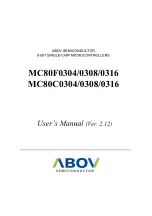
MOT CONNECTION
The two ports marked with MOT on the Tmax are only operational when Static Depth Controller TAES is connected.
As Static Depth Control is only effective whilst the model is static (submerged at zero velocity), TAES mode is automatically terminated
with the main drive in operation. The deactivation minimizes unnecessary strain on the system by eliminating unintentional automatic
trimming of the Piston Tanks with the main drive in operation. This is also beneficial in terms of power consumption.
The stimulus threshold for this automatic termination for 12V systems is at about 30% speed or higher. For 6V operation threshold value
might proof to be much higher or not effective at all. If the latter is the case the TAES mode must be terminated manually.
Excessive trimming may lead to system overload. However, a so-called "fallback function" will ensure safe resurfacing of the model. In
such an extreme case just give the command "resurface" and allow the model to emerge up to sea level. This will ensure a full reset of
the system, after which all functions will then become fully operational again.
FURTHER CONNECTIONS
For connection of the nozzles of the Piston Tanks PVC hosing 9/6 mm is used. These connect to outboard tubing connectors 8x16 mm
(item no. 1589-401).
Outboard tubing connectors must be glued in with 2-component adhesive (e.g. 1-Hour Epoxy, item no. 9507). In general, hoses must
not be fixed with cable ties or similar but are held securely down to a depth of 25 m [i.e. 2.5 bar]).
The WTC should be equipped with a breather made of a piece of brass tube and PVC hose. The breather allows pressure equalization
and, furthermore, for blowing pressure into the hull to identify possible leakages. The brass tube should lie at the lowest point of the
WTC. The hose is pushed onto the brass tube from the outside and closed-off with a knob (e.g. brass rod dia. 5 x 30 mm). If the hull is
pressurized through the tube (with the mouth - DO NOT use a pump!) any water inside the hull (for whatever reason) will be forced out
through the tubing. This allows you to verify that really everything is absolutely "pressure proof".
Submarine type VII/c already incorporates a breather fitted within the main drive unit.
FURTHER SETTINGS
P1: Loss of Signal
Tmax features a safety device which forces the model to resurface in case that transmitter signal is interrupted for a specific time span.
This downtime can be adjusted by resetting the JUMPER on contact pins P1.
• contact pins P1 are connected (bridged) by JUMPER downtime set to approx. 2 sec.
• JUMPER is only set on a single pin downtime approx. 5 sec.
Default setting is approx. 2 sec. (pins are bridged by JUMPER) and recommended for operation allowing rather limited visibility of the
model (e. g. in lakes). If used in pools the downtime can be set to 5 sec., as interruption of transmitter signal is mainly caused by the
construction of the pool itself and risk of losing the boat is basically zero.
As soon as transmitter signal is picked-up again the system will return to the functional mode given at that time. Therefore, the model
might not resurface fully if the submerge mode is still activated by the transmitter.
VOLT: Battery Monitor
An additional safety feature of the Tmax is the integrated Battery Monitor. This device permanently verifies adequate power supply of
the main battery for safe operation of the boat.
Threshold voltage for 6 Volt system is preset to approx. 4 Volt, for 12 Volt systems to approx. 9 Volt. Threshold voltage can be adjusted
via the potentiometer on board of the Tmax. However, a regulated power supply is recommended to achieve an exact setting.
• potentiometer turned clockwise threshold voltage is decreased
• potentiometer turned anti-clockwise threshold voltage is increased
With the voltage dropping below the preset threshold value, the piston tanks will start to press water out of the cylinders. If this is the
case, the bow-sided tank will start to press out ballast water first. After a pause of about 15 sec. the stern tank will start to empty. This
sequence is to minimize the strain on the already weakened battery pack. After a low battery voltage has been identified further opera-
tion of the system will only be possible after the battery pack has been fully charged.
The second green LED [LED6] serves as monitor-LED for optical evaluation of remaining main battery voltage. Furthermore, LED6 faci-
litates adjustment of threshold voltage via the potentiometer of the battery monitor. The darker LED6, the lower main battery voltage
(relative to threshold value).
Copyright ©2008 ALEXANDER ENGEL KG
Tmax
V2
Item No. 1584-TMX
7






























